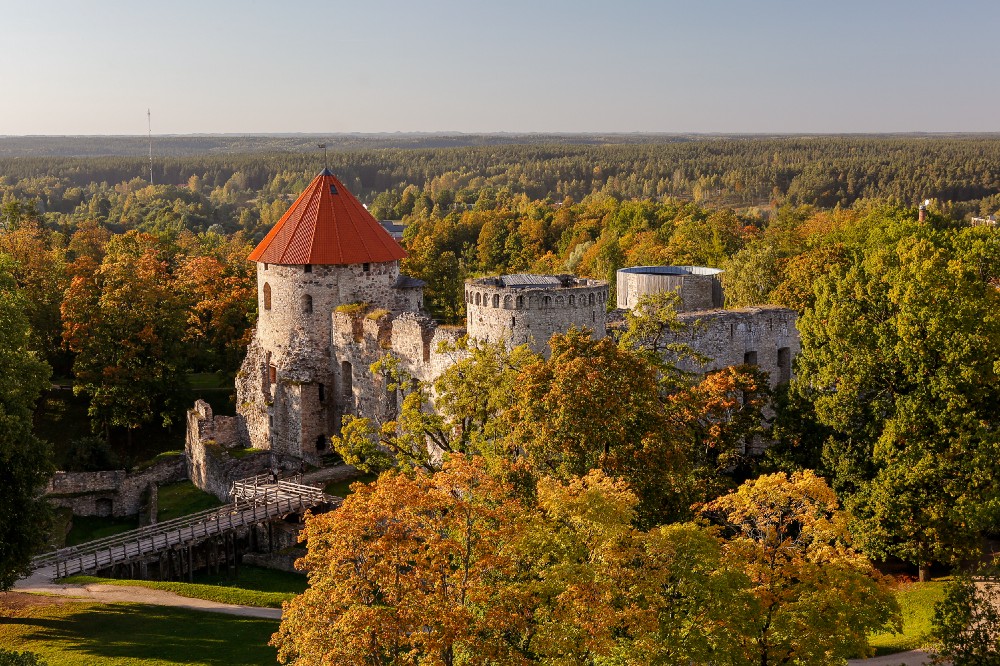Augmented Urbans Local Action: Inspiring a new future for a resort in Cesis forests
When one arrives in the medieval old town and curvy streets of Cēsis, Latvia, a tall, mighty yet shabby church and a once-majestic castle form the face of the town. Only those who have invested some time in research, or who have looked into maps more closely, will notice the vast green and forested territories and Gauja river to the east of the old town. What was once a territory for silent, almost off-the-grid living, beautiful wooden architecture and summer residences, is now a part of Cēsis nature and cultural-historical park reserve, and will be investigated and re-imagined in duration of the Augmented Urbans project.
Background
Although Cēsis is by and large a green city, a number of its green and blue territories are not sustained, enjoyed and maintained properly, including the pilot-site near Gauja river. There are several issues the local team has identified during the first phase of the project, but most pressing of them all is the sheer potential this place embodies. Gauja River has always been an important part of Cēsis locality, yet it has drifted away from the minds and day-to-day destinations of both local inhabitants, and visitors alike.
Dream of a resort
During the early 20th century, the territory along the river was a regionally popular resort renowned for its medical spas and stellar views of the river, making it popular with locals and out-of-towners alike. For much of the Soviet years, the area was left in a disarray only to find a new start during the last decade. The pilot site now includes a budding ski resort, fantastic landscape views of the Gauja river relief, walking and hiking trails in the forests, along Gauja and impressive sandstone cliffs, architectural heritage and spa hotels, natural resources (fresh air, mineral waters etc.), among other things. That said, there are also restrictions for the potential uses and development of the pilot site as there are several zoning stipulations in the Cēsis nature and cultural-historical park, including nature reserve territories with protected habitats, nature park area and landscape protection zone. While restrictions are in place, the area also presents major development opportunities with respect to its historic and natural values.
Local actions
To investigate the potential uses for territory (resort, ecosystem services, necessary services, access), the project envisions a number of local actions.
Planner’s forum
The first in a series of local actions is a local planner’s forum which is going to explore a number of issues. The first part of the forum will feature lectures and debates in which the local project leaders and planners survey and discuss the advantages of employing digital technology in territorial planning, and debate how to integrate and synchronize these with more analog practices in participatory planning at the regional level.
The second part of the forum will engage participants into team-based design thinking workshops to create scenarios for sustainable riverside development from the perspective of various user groups and time frames — from 12 to 48 hours and during different seasons of the year.
May: Testing scenarios with local inhabitants and business owners
Ideas generated throughout the planner’s forum will be turned into infographics and tested with local inhabitants and business community. Our goal is to flesh out the main tenets presented during the planners forum and see if our local site can deliver services identified by various stakeholder groups.
June: “Lampa: A Conversation Festival”
During the last week of June, the city of Cēsis hosts an annual conversation festival “Lampa” and becomes a hotspot for all the topical issues in society. Augmented Urbans, along the City Council of Cēsis, will use this opportunity to showcase the best practices of using digital technology in participatory planning. We will also engage with the thousands of visitors in Cēsis for the weekend to explore their ideas and views regarding our local action site by the river Gauja.
August: Aero
During July and August, the project partner Institute for Environmental Solutions Institute (IES) will gather hi-res visual data of our Local Action site by using their unique ‘flying laboratory’ technology. The Local Action will give invaluable information on the state of ecosystem services at the site and enable us to map the potential of the area. Lastly, the data will provide a more robust footing for us to draft a resilient vision for the Local Action site and evaluate the potential for the development of the resort projects.
September: Local Action site hackathon
In cooperation with regional universities, project partners, startups and green technology accelerator, we are planning to host a 48-hour hackathon in Cesis on our Local Action site. Our goal is to test, validate and make the most of the vast data sets gathered throughout the first part from our Local Action site. Participants will be asked to create services and solutions for a range of end users by keeping in mind both the regulatory framework on the one hand and the rich ecosystem services on the other.
This blog article is prepared within Augmented Urban project framework.

